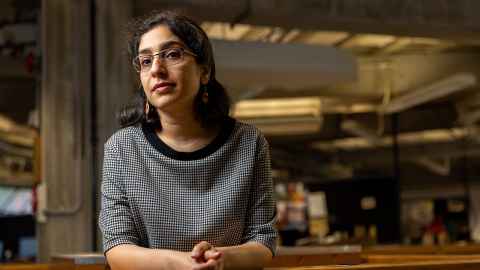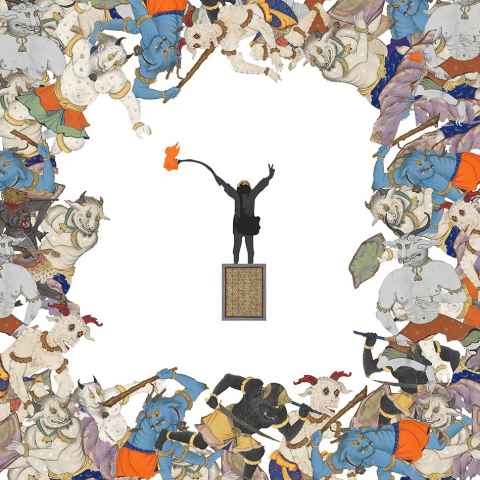Farzaneh Haghighi: 'Iranian women aren’t strangers to struggle'
30 November 2022
Opinion: Dr Farzaneh Haghighi is an Iranian-Kiwi. She reflects on the 'Woman, Life, Freedom' movement and how it is built on the courage of women who have gone before.

With a feminist urban social movement sweeping Iran in response to the murder of 22-year-old Mahsa (Zhina) Amini in September by the ‘morality police’, I have found myself disturbed by the unprecedented violence against the Iranian people.
I am also inspired by brave schoolgirls, amazed by revolutionary artworks and songs created every day, and disheartened by the prolonged silence of international organisations over the death of Mahsa. I think back to the global solidarity that rose within hours over the killing of George Floyd in the US, and feel frustrated by simplified and biased mainstream media narratives over Iran.
Widespread protests against the killing of Mahsa and, more widely, the mandatory hijab, have led to tragic bloodshed in Iran. As I write, 326 have been killed, including 43 children, in this latest uprising.
The time has come to dismantle the binary division between the oppressed traditional global-south and the free democratic modern global-north. Police brutality, the anti-democracy project of neoliberal economies and the rise of authoritarianism are shared problems in our globalised world.
The latest Iran protests, with the slogan of ‘Woman, Life, Freedom’, are now about demanding the right to live. They are non-violent movements and not an invitation for military intervention. They are not advocating for separatism, nor are they an attack on Islam or the hijab.
The state use of excessive and lethal force has for a long time brutally crushed dissidence in Iran. For example, the Green Movement of 2009 that arose in response to election fraud, was violently oppressed with at least 71 killed and 10,000 arrested. From 2017, there were protests by educated, young and largely unemployed middle-class poor in reaction to high prices. These led to at least 25 being killed and 3,700 arrested. In 2019, in protests following crippling fuel prices, up to 1,500 people, including children, were killed by Iran’s security forces and 7,000 arrested.
By way of background, most of Iran’s population of 85 million is struggling, with inflation at 40 percent and unemployment at just under ten percent. GDP decreased 55 percent from 2012 to 2019, and 38 percent of the population now lives below the poverty line. Under US sanctions, Iran’s currency continues to lose value, and the UN has announced the sanctions are harming Iranians’ right to health. The livelihood of ordinary Iranian people is in a parlous state, thanks to corruption on the inside and sanctions from the outside.
According to US political scientist Professor Dursun Peksen, economic sanctions empower authoritarian regimes. The targeted regime hoards and controls the scarce resources, and also blocks opposition access to any funds. Sanctions also lead to the deterioration of human rights. The targeted country’s isolation from global economies and political influences reduces the opportunity for international organisations to make the regime accountable for violence against its citizens. This can be a gift to authoritarian regimes to freely accelerate violence against their citizens.
Violence against the Iranian people, whether by the autocratic regime of Islamists or economic wars wrapped in the rhetoric of humanitarian interventions or sanctions, must be condemned.
The latest Iran protests are now about demanding the right to live.
Iranian women aren’t strangers to struggle – they’ve been familiar with it since the roots of modern Iranian feminism were firmly planted during the constitutional revolution of 1905-1911. A notable event was the emergence of mezzo-soprano Ghamar-ol-Molouk Vaziri (1905–1959) who became the first woman to sing highly charged political songs in public without hijab.
Today’s movement is built on the courage of the women who have gone before, but also on the unimaginable determination of Iranian women – and men – who are redefining what non-violent democratic resistance means.
People like the Iranian women’s basketball team who removed their hijab and posted the image on Instagram recently, using the 'Woman, Life, Freedom' slogan. And Elaheh Mohammadi and Niloofar Hamedi, the two journalists who first published the photo of Mahsa on the hospital bed, which played a significant role in publicising her murder. But arrested, imprisoned and accused of being spies of Western and Zionist intelligence agencies, they could be sentenced to death. Journalist and activist Noushin Ahmadi Khorasani, founder of the ‘One Million Signatures Campaign’ repealing discriminatory laws against women, was sent to prison for three years in 2007 accused of ‘threatening national security’.

I am also inspired by brave schoolgirls, amazed by revolutionary artworks and
songs created every day, and disheartened by the prolonged silence of
international organisations over the death of Mahsa.
Bahareh Hedayat, a women’s rights activist, was arrested in 2019 and is still in prison over a Tweet announcing she would attend the mourning for the victims of the Flight 752. Nasrin Sotoudeh, a human rights lawyer, represented various imprisoned political and human right activists including Iranian Nobel Peace Prize Laureate Shirin Ebadi. Nasrin was arrested several times before being charged with espionage in 2018 and sentenced to 38 years in prison. This year, Iranian rock climber Elnaz Rekabi broke the mandatory hijab laws of the Islamic regime by competing without a headscarf in South Korea, and is now under home arrest in Iran.
These heroines prompt me to ponder my role in making life possible for the many who are stripped of all rights, from the right to have access to medicine or the internet; to the right to use public spaces without being shot dead.
While practising as an architect, I participated in the 2009 Green Movement, a revolutionary event that prompted me to return to academia to study the nexus between urban space and social movement.
What I can say is that a collective movement within a public space in Iran is generally controlled with a high likelihood of oppression, because public spaces are policed. Praise for social movements or admiration of the brave dissidents often ignores the high price being paid on urban streets. The streets may be the only space left for Iranian people to express discontent, but their lives are not, and should never be, rendered disposable.
Standing in solidarity with Iranian people means understanding their fight not as an inexplicable event within the boundaries of a country, but recognising the body politic is alive and universal. This body should assert the right to live and for people to determine their own destiny, beyond any autocratic regime or humanitarian interventions.
Dr Farzaneh Haghighi is a senior lecturer in architecture at the School of Architecture and Planning, Faculty of Creative Arts and Industries, Waipapa Taumata Rau, University of Auckland.
She is a co-editor of The Routledge Handbook of Architecture, Urban Space and Politics (2022)
The views in this article are personal opinion and are not necessarily those of the University of Auckland.
This piece was first published in the December 2022 edition of UniNews.